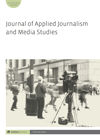
Full text loading...

 , Stefanie Markidis1
, Stefanie Markidis1
While critical reflection has been identified as a useful and important practice for journalists, researchers highlight pushback from practitioners who say reflection is too ‘academic’, too time-consuming and a threat to their professional autonomy and identity. However, a survey of Australian journalists shows them to be reflective upon their practice of the ‘death knock’, in which they seek to interview the family of someone who has died in newsworthy circumstances. This article reflects on findings of Watson’s 2021 survey of 100 journalists’ death knock practice. Through qualitative responses, analysed through the lens of Donald Schon’s ‘reflective practitioner’, journalists demonstrate their capacity for reflection-in-action and reflection-on-action in their death knock practice. While journalists refine their practices through reflection, their professional tasks remain greatly influenced by newsroom pressures. Journalists’ tacit negotiation of pressures can be understood as Bourdieusian habitus. Through Bourdieu’s conception of constituent and constitutive ‘feel for the game’, we expose a paradox: no matter what clout a journalist develops, they remain constrained by newsroom culture. In the face of this paradox, we follow the call from survey participants for a holistic approach to education and support.

Article metrics loading...

Full text loading...
References


Data & Media loading...
Publication Date:
https://doi.org/10.1386/ajms_00134_1 Published content will be available immediately after check-out or when it is released in case of a pre-order. Please make sure to be logged in to see all available purchase options.